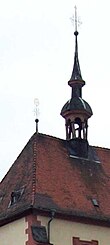Jesuit Church (Aschaffenburg)
Jesuit Church Heiligste Dreifaltigkeit is a church in Aschaffenburg built between 1619 and 1621 . In 1810 it was converted into a study church in the spirit of the times , destroyed in the Second World War and then profaned . Since 1990 it has served the city of Aschaffenburg as an art gallery, Jesuit church (museums of the city of Aschaffenburg).
history
Elector - Archbishop Johann Schweikhard von Kronberg summoned the Jesuits to his second residence in Aschaffenburg in 1612 , where he had Johannisburg Castle built from 1605 to 1614 . The archbishop allocated them income from the abolished Cistercian convent Himmelthal for their maintenance .
Church building

The construction of the church began as an outwardly simple “domestic” Renaissance building in 1619. It is a single-nave complex with an octagonal roof turret with inclined pillars , a semicircular apse with domed vault, lantern and covered gallery . The nave has three bays with side chapels of shallow depth and windows with a straight lintel , above in the upper aisle small arched windows . The facade also has a square edge in a runner-truss pattern. The figures of Christ Salvator and Immaculate stand in the round niches flanking the portal . The doorway is round-arched with a straight roof, on which there is a cartouche with the monogram of Christ , held by angels and flanked by obelisks . The arched windows have a straight roof.
The interior design is in the style of the Italian Baroque , with rich stucco work. In 1796 the church was used as a magazine. During renovation work in 1810, the church's altars were removed and whitewashed in accordance with the spirit of the times. In 1836 a tabernacle altar in the classicism style made of stucco marble , made in Würzburg , was set up.
The church was totally destroyed in the Second World War. The city of Aschaffenburg acquired the building from the Diocese of Würzburg and had it rebuilt in the 1980s. Today it is profaned by the Jesuit Church, a gallery of the museums of the city of Aschaffenburg. The stucco work has been partially restored. The upstream residential building, popularly known as the Dreidippehaus (three classical vases in the gable), was demolished in the course of the tunneling under the town hall square.
The following items of art should be mentioned:
- An early baroque monstrance, made around 1720–1730 from silver, partially gold-plated, with red and green enamel parts, depicting the root of Jesse . At the foot there are chased silver figures ( progenitors ), in the sun the trunk branches out into two branches (figures Maria and Joseph), above the lunula there is God the Father and the Holy Spirit under a canopy . The conclusion is a crown with two angels and the cross.
- A silver carrying figure ( procession ) of St. Maria de Victoria has Mary with child, crown and scepter standing on the globe on a rococo wooden base, the aureole decorated with twelve stars. The whole figure is surrounded by a gilded halo. The two objects are the property of the Marian Congregation (MC) or, today, the Marian male modality. This figure is in the monastery museum, but is still carried during processions.
Web links
- Photos from 1937 to 1946 in the index
- City of Aschaffenburg - Jesuit Church Art Hall
- Museums of the city of Aschaffenburg - Kunsthalle Jesuitenkirche
Individual evidence
- ↑ http://www.vdu.uni-koeln.de/vdu/DE-StAW/AschaffenburgJesuiten/fond
- ↑ The Archdiocese of Mainz was often ruled from Aschaffenburg. Of the 40 elector-archbishops, Werner von Eppstein (1259–1284) to Friedrich Karl Joseph von Erthal (1774–1802), 15 died in Aschaffenburg. Almost all of them were transferred to Mainz and buried in St. Martin's Cathedral, with the intestine also remaining in Aschaffenburg. Three elector-archbishops, namely Dietrich Schenk von Erbach (1390–1459), Anselm Franz von Ingelheim (1634–1695) and Friedrich Karl Joseph von Erthal , found their final resting place in the collegiate church of Aschaffenburg. Albrecht von Brandenburg, who came to Aschaffenburg after his expulsion from Halle in 1541, had Hans Vischer cast a tomb for the collegiate church of Aschaffenburg (more precisely: a "memorial", because he died on September 24, 1545 in the Martinsburg in Mainz and was in Cathedral buried), but died in Mainz. The last Elector of Mainz, Karl Theodor von Dalberg, died as Archbishop of Regensburg and was buried there in Regensburg Cathedral . His heart urn is in the collegiate church of Aschaffenburg.
- ↑ Haus'sche Chronicle urban and Stiftsarchiv Aschaffenburg
- ^ Felix Mader : The art monuments of the Kingdom of Bavaria - Lower Franconia XIX, city of Aschaffenburg . Munich 1918.
- ↑ September 5, 1973: Official order of the Episcopal Ordinariate of Würzburg for profanation: “The previous church building must not be made to serve any unworthy use by the city of Aschaffenburg or its possible later legal successor.” Alois Grimm: Aschaffenburger Häuserbuch. Volume II: Old town between Dalbergstrasse and the castle ... Geschichts- und Kunstverein e. V., Aschaffenburg 1991, ISBN 3-87965-053-5 , that's why the graves remained in the Jesuit church.
- ↑ http://webmuseen.de/kunsthalle-jesuitenkirche-aschaffenburg.html
Coordinates: 49 ° 58 ′ 31 ″ N , 9 ° 8 ′ 38 ″ E


